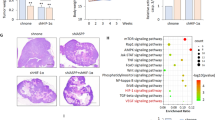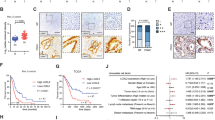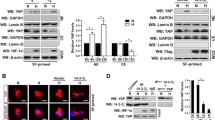Abstract
Hypoxia is linked to epithelial–mesenchymal transition (EMT) and tumor progression in numerous carcinomas. Responses to hypoxia are thought to operate via hypoxia-inducible factors (HIFs), but the importance of co-factors that regulate HIF signaling within tumors is not well understood. Here, we elucidate a signaling pathway that physically and functionally couples tyrosine phosphorylation of β-catenin to HIF1α signaling and HIF1α-mediated tumor EMT. Primary human lung adenocarcinomas accumulate pY654-β-catenin and HIF1α. All pY654-β-catenin, and only the tyrosine phosphorylated form, was found complexed with HIF1α and active Src, both within the human tumors and in lung tumor cell lines exposed to hypoxia. Phosphorylation of Y654, generated by hypoxia mediated, reactive oxygen species (ROS)-dependent Src kinase activation, was required for β-catenin to interact with HIF1α and Src, to promote HIF1α transcriptional activity, and for hypoxia-induced EMT. Mice bearing hypoxic pancreatic islet adenomas, generated by treatment with anti-vascular endothelial growth factor antibodies, accumulate HIF1α/pY654-β-catenin complexes and develop an invasive phenotype. Concurrent administration of the ROS inhibitor N-acetylcysteine abrogated β-catenin/HIF pathway activity and restored adenoma architecture. Collectively, the findings implicate accumulation of pY654-β-catenin specifically complexed to HIF1α and Src kinase as critically involved in HIF1α signaling and tumor invasion. The findings also suggest that targeting ROS-dependent aspects of the pY654-β-catenin/ HIF1α pathway may attenuate untoward biological effects of anti-angiogenic agents and tumor hypoxia.
This is a preview of subscription content, access via your institution
Access options
Subscribe to this journal
Receive 50 print issues and online access
$259.00 per year
only $5.18 per issue
Buy this article
- Purchase on Springer Link
- Instant access to full article PDF
Prices may be subject to local taxes which are calculated during checkout








Similar content being viewed by others
References
Polyak K, Weinberg RA . Transitions between epithelial and mesenchymal states: acquisition of malignant and stem cell traits. Nat Rev Cancer 2009; 9: 265–273.
Yang J, Mani SA, Donaher JL, Ramaswamy S, Itzykson RA, Come C et al. Twist, a master regulator of morphogenesis, plays an essential role in tumor metastasis. Cell 2004; 117: 927–939.
Thiery JP, Acloque H, Huang RY, Nieto MA . Epithelial-mesenchymal transitions in development and disease. Cell 2009; 139: 871–890.
Turley EA, Veiseh M, Radisky DC, Bissell MJ . Mechanisms of disease: epithelial-mesenchymal transition–does cellular plasticity fuel neoplastic progression? Nat Clin Pract Oncol 2008; 5: 280–290.
Lu X, Kang Y . Hypoxia and hypoxia-inducible factors: master regulators of metastasis. Clin Cancer Res 2010; 16: 5928–5935.
Hung JJ, Yang MH, Hsu HS, Hsu WH, Liu JS, Wu KJ . Prognostic significance of hypoxia-inducible factor-1alpha, TWIST1 and Snail expression in resectable non-small cell lung cancer. Thorax 2009; 64: 1082–1089.
Ruan K, Song G, Ouyang G . Role of hypoxia in the hallmarks of human cancer. J Cell Biochem 2009; 107: 1053–1062.
De Bock K, Mazzone M, Carmeliet P . Antiangiogenic therapy, hypoxia, and metastasis: risky liaisons, or not? Nat Rev Clin Oncol 2011; 8: 393–404.
Paez-Ribes M, Allen E, Hudock J, Takeda T, Okuyama H, Vinals F et al. Antiangiogenic therapy elicits malignant progression of tumors to increased local invasion and distant metastasis. Cancer Cell 2009; 15: 220–231.
Klimova T, Chandel NS . Mitochondrial complex III regulates hypoxic activation of HIF. Cell Death Differ 2008; 15: 660–666.
Cannito S, Novo E, Compagnone A, Valfre di Bonzo L, Busletta C, Zamara E et al. Redox mechanisms switch on hypoxia-dependent epithelial-mesenchymal transition in cancer cells. Carcinogenesis 2008; 29: 2267–2278.
Krishnamachary B, Zagzag D, Nagasawa H, Rainey K, Okuyama H, Baek JH et al. Hypoxia-inducible factor-1-dependent repression of E-cadherin in von Hippel-Lindau tumor suppressor-null renal cell carcinoma mediated by TCF3, ZFHX1A, and ZFHX1B. Cancer Res 2006; 66: 2725–2731.
Luo D, Wang J, Li J, Post M . Mouse snail is a target gene for HIF. Mol Cancer Res 2011; 9: 234–245.
Yang MH, Wu MZ, Chiou SH, Chen PM, Chang SY, Liu CJ et al. Direct regulation of TWIST by HIF-1alpha promotes metastasis. Nat Cell Biol 2008; 10: 295–305.
Kaluz S, Kaluzova M, Stanbridge EJ . Regulation of gene expression by hypoxia: integration of the HIF-transduced hypoxic signal at the hypoxia-responsive element. Clin Chim Acta 2008; 395: 6–13.
Kaidi A, Williams AC, Paraskeva C . Interaction between beta-catenin and HIF-1 promotes cellular adaptation to hypoxia. Nat Cell Biol 2007; 9: 210–217.
Stemmer V, de Craene B, Berx G, Behrens J . Snail promotes Wnt target gene expression and interacts with beta-catenin. Oncogene 2008; 27: 5075–5080.
Yook JI, Li XY, Ota I, Hu C, Kim HS, Kim NH et al. A Wnt-Axin2-GSK3beta cascade regulates Snail1 activity in breast cancer cells. Nat Cell Biol 2006; 8: 1398–1406.
Morin PJ . beta-catenin signaling and cancer. Bioessays 1999; 21: 1021–1030.
Polakis P . The oncogenic activation of beta-catenin. Curr Opin Genet Dev 1999; 9: 15–21.
Roura S, Miravet S, Piedra J, Garcia de Herreros A, Dunach M . Regulation of E-cadherin/Catenin association by tyrosine phosphorylation. J Biol Chem 1999; 274: 36734–36740.
Kim KK, Wei Y, Szekeres C, Kugler MC, Wolters PJ, Hill ML et al. Epithelial cell alpha3beta1 integrin links beta-catenin and Smad signaling to promote myofibroblast formation and pulmonary fibrosis. J Clin Invest 2009; 119: 213–224.
Kim Y, Kugler MC, Wei Y, Kim KK, Li X, Brumwell AN et al. Integrin alpha3beta1-dependent beta-catenin phosphorylation links epithelial Smad signaling to cell contacts. J Cell Biol 2009; 184: 309–322.
Ulsamer A, Wei Y, Kim KK, Tan K, Wheeler S, Xi Y et al. Axin pathway activity regulates in vivo pY654-beta-catenin accumulation and pulmonary fibrosis. J Biol Chem 2012; 287: 5164–5172.
Lilien J, Balsamo J . The regulation of cadherin-mediated adhesion by tyrosine phosphorylation/dephosphorylation of beta-catenin. Curr Opin Cell Biol 2005; 17: 459–465.
Zeng G, Apte U, Micsenyi A, Bell A, Monga SP . Tyrosine residues 654 and 670 in beta-catenin are crucial in regulation of Met-beta-catenin interactions. Exp Cell Res 2006; 312: 3620–3630.
Karni R, Dor Y, Keshet E, Meyuhas O, Levitzki A . Activated pp60c-Src leads to elevated hypoxia-inducible factor (HIF)-1alpha expression under normoxia. J Biol Chem 2002; 277: 42919–42925.
Jiang BH, Agani F, Passaniti A, Semenza GL . V-SRC induces expression of hypoxia-inducible factor 1 (HIF-1) and transcription of genes encoding vascular endothelial growth factor and enolase 1: involvement of HIF-1 in tumor progression. Cancer Res 1997; 57: 5328–5335.
Pham NA, Magalhaes JM, Do T, Schwock J, Dhani N, Cao PJ et al. Activation of Src and Src-associated signaling pathways in relation to hypoxia in human cancer xenograft models. Int J Cancer 2009; 124: 280–286.
Pennacchietti S, Michieli P, Galluzzo M, Mazzone M, Giordano S, Comoglio PM . Hypoxia promotes invasive growth by transcriptional activation of the met protooncogene. Cancer Cell 2003; 3: 347–361.
Campbell PJ, Yachida S, Mudie LJ, Stephens PJ, Pleasance ED, Stebbings LA et al. The patterns and dynamics of genomic instability in metastatic pancreatic cancer. Nature 2010; 467: 1109–1113.
Zhou G, Dada LA, Wu M, Kelly A, Trejo H, Zhou Q et al. Hypoxia-induced alveolar epithelial-mesenchymal transition requires mitochondrial ROS and hypoxia-inducible factor 1. Am J Physiol Lung Cell Mol Physiol 2009; 297: L1120–L1130.
Littlepage LE, Sternlicht MD, Rougier N, Phillips J, Gallo E, Yu Y et al. Matrix metalloproteinases contribute distinct roles in neuroendocrine prostate carcinogenesis, metastasis, and angiogenesis progression. Cancer Res 2010; 70: 2224–2234.
Lluis JM, Buricchi F, Chiarugi P, Morales A, Fernandez-Checa JC . Dual role of mitochondrial reactive oxygen species in hypoxia signaling: activation of nuclear factor-{kappa}B via c-SRC and oxidant-dependent cell death. Cancer Res 2007; 67: 7368–7377.
Setsukinai K, Urano Y, Kakinuma K, Majima HJ, Nagano T . Development of novel fluorescence probes that can reliably detect reactive oxygen species and distinguish specific species. J Biol Chem 2003; 278: 3170–3175.
Casanovas O, Hicklin DJ, Bergers G, Hanahan D . Drug resistance by evasion of antiangiogenic targeting of VEGF signaling in late-stage pancreatic islet tumors. Cancer Cell 2005; 8: 299–309.
Sennino B, Ishiguro-Oonuma T, Wei Y, Naylor RM, Williamson CW, Bhagwandin V et al. Suppression of tumor invasion and metastasis by concurrent inhibition of c-Met and VEGF signaling in pancreatic neuroendocrine tumors. Cancer Discov 2012; 2: 270–287.
Jones S, Chen WD, Parmigiani G, Diehl F, Beerenwinkel N, Antal T et al. Comparative lesion sequencing provides insights into tumor evolution. Proc Natl Acad Sci USA 2008; 105: 4283–4288.
Kim WY, Perera S, Zhou B, Carretero J, Yeh JJ, Heathcote SA et al. HIF2alpha cooperates with RAS to promote lung tumorigenesis in mice. J Clin Invest 2009; 119: 2160–2170.
Lu KV, Chang JP, Parachoniak CA, Pandika MM, Aghi MK, Meyronet D et al. VEGF inhibits tumor cell invasion and mesenchymal transition through a MET/VEGFR2 complex. Cancer Cell 2012; 22: 21–35.
Lou YW, Chen YY, Hsu SF, Chen RK, Lee CL, Khoo KH et al. Redox regulation of the protein tyrosine phosphatase PTP1B in cancer cells. FEBS J 2008; 275: 69–88.
Yang W, Xia Y, Ji H, Zheng Y, Liang J, Huang W et al. Nuclear PKM2 regulates beta-catenin transactivation upon EGFR activation. Nature 2011; 480: 118–122.
Grepin R, Pages G . Molecular mechanisms of resistance to tumour anti-angiogenic strategies. J Oncol 2010; 2010: 835680.
Keunen O, Johansson M, Oudin A, Sanzey M, Rahim SA, Fack F et al. Anti-VEGF treatment reduces blood supply and increases tumor cell invasion in glioblastoma. Proc Natl Acad Sci USA 2011; 108: 3749–3754.
Mao W, Irby R, Coppola D, Fu L, Wloch M, Turner J et al. Activation of c-Src by receptor tyrosine kinases in human colon cancer cells with high metastatic potential. Oncogene 1997; 15: 3083–3090.
Acknowledgements
We thank Roshni Ray, Mazen Sidani, Toshina Ishiguro-Oonuma, Casey W Williamson, Thomas Kim, Yonghyun Kim, Yang Gao and Ronald Tsang for technical assistance; and Drs Miguel Ramalho Santos and Martin Brown for generous gifts of reagents. This work was supported by NIH Grants to HL-44712 and CA-125564 (HAC).
Author information
Authors and Affiliations
Corresponding authors
Ethics declarations
Competing interests
The authors declare no conflict of interest.
Additional information
Supplementary Information accompanies the paper on the Oncogene website
Supplementary information
Rights and permissions
About this article
Cite this article
Xi, Y., Wei, Y., Sennino, B. et al. Identification of pY654-β-catenin as a critical co-factor in hypoxia-inducible factor-1α signaling and tumor responses to hypoxia. Oncogene 32, 5048–5057 (2013). https://doi.org/10.1038/onc.2012.530
Received:
Revised:
Accepted:
Published:
Issue Date:
DOI: https://doi.org/10.1038/onc.2012.530
Keywords
This article is cited by
-
A reversible SRC-relayed COX2 inflammatory program drives resistance to BRAF and EGFR inhibition in BRAFV600E colorectal tumors
Nature Cancer (2023)
-
Signaling pathways and mesenchymal transition in pediatric high-grade glioma
Cellular and Molecular Life Sciences (2018)
-
Long noncoding RNA NORAD, a novel competing endogenous RNA, enhances the hypoxia-induced epithelial-mesenchymal transition to promote metastasis in pancreatic cancer
Molecular Cancer (2017)
-
Redox regulation in tumor cell epithelial–mesenchymal transition: molecular basis and therapeutic strategy
Signal Transduction and Targeted Therapy (2017)
-
Hypoxia-induced modulation of PTEN activity and EMT phenotypes in lung cancers
Cancer Cell International (2016)



